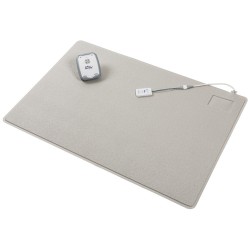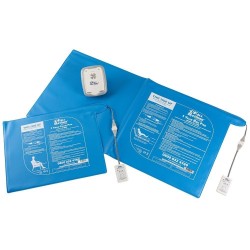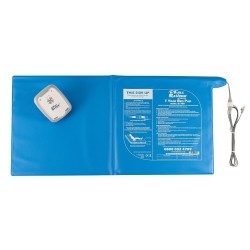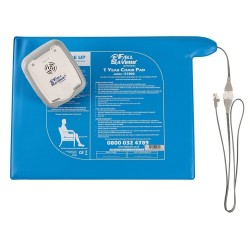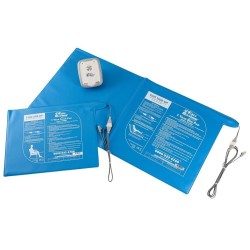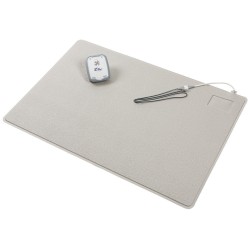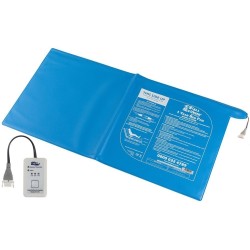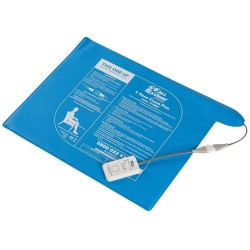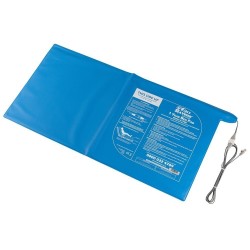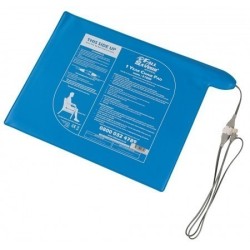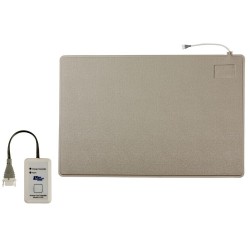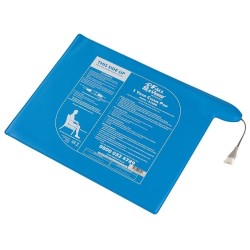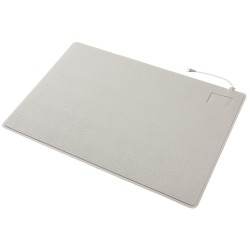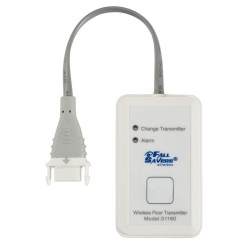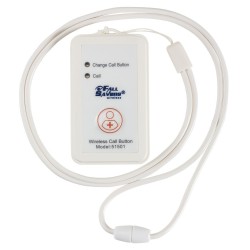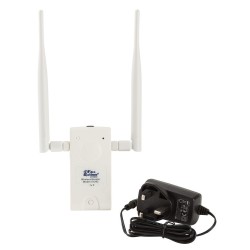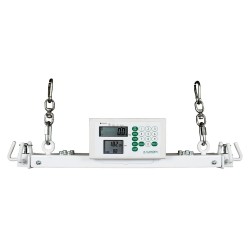Care Store
Subcategories
Patient Monitoring Alarms
Patient Monitoring Systems for Falls Prevention
Patient monitoring alarms provide early warning of patient movement, supporting falls prevention strategies in clinical settings where patient safety surveillance is essential. These alarm systems integrate bed and chair sensors with nurse call systems, alerting healthcare staff to patient mobilization attempts that may indicate falls risk, enabling timely intervention that prevents patient injuries while maintaining dignity through least restrictive monitoring approaches.
Falls prevention requires monitoring solutions that balance patient safety with dignity and autonomy, avoiding physical restraints while maintaining appropriate surveillance. Our alarm systems offer adjustable sensitivity, multiple alarm zones, and integration capabilities that support individualized falls risk management. Clinical evidence supports sensor alarm effectiveness in reducing falls-related injuries when implemented within comprehensive falls prevention protocols including risk assessment and environmental modification.
Healthcare professionals can select from wired systems integrating with existing nurse call infrastructure or wireless solutions offering flexible deployment across clinical areas. Systems support falls prevention protocols meeting NHS safety standards, providing monitoring capability that protects high-risk patients while supporting person-centered care approaches that minimize restrictive practices and maintain patient autonomy within safe care parameters.
Active Pressure Relief...
Dynamic Pressure Redistribution for Clinical Pressure Ulcer Prevention
Active pressure relief systems utilize alternating pressure technology to provide continuous pressure redistribution, supporting pressure ulcer prevention for patients at high risk who require therapeutic surfaces beyond static support. These powered systems alternate air cell inflation according to clinical protocols, promoting tissue perfusion and reducing sustained pressure that causes tissue ischemia, providing essential pressure care for immobile patients requiring intensive pressure management.
Clinical evidence demonstrates active pressure redistribution effectiveness in preventing pressure ulcers in high-risk patients including those with complete immobility, compromised tissue perfusion, or existing pressure damage. Our systems offer adjustable cycle times, pressure settings, and comfort modes supporting individualized therapy based on clinical assessment. Medical device certification and clinical validation ensure systems deliver therapeutic pressure relief meeting evidence-based pressure ulcer prevention guidelines.
Healthcare professionals can select systems appropriate to clinical risk levels, considering patient weight, mobility status, and existing skin integrity. Integration with standard hospital beds and bariatric frames ensures clinical applicability across patient populations. Quiet operation, low maintenance requirements, and reliable performance support therapeutic pressure care that prevents complications while maintaining patient comfort throughout extended bed rest periods required by clinical conditions.
Pressure Relief Cushions
Seating Pressure Redistribution for Clinical Settings
Pressure relief cushions provide therapeutic seating surfaces that redistribute pressure during prolonged sitting, supporting pressure ulcer prevention for patients using wheelchairs or spending extended periods in seated positions. These specialized cushions utilize foam, gel, or combination technologies to reduce interface pressures at ischial tuberosities and sacral areas, providing essential pressure management for patients whose sitting tolerance exceeds safe pressure exposure thresholds without therapeutic intervention.
Seating pressure creates significant pressure ulcer risk due to concentrated loading at bony prominences and reduced tissue tolerance during sustained sitting. Clinical assessment determines appropriate cushion technology based on patient risk factors, postural requirements, and functional activities. Pressure mapping and clinical evidence guide cushion selection, ensuring therapeutic pressure redistribution that balances pressure relief with postural stability necessary for functional activities and patient safety during wheelchair use.
Healthcare professionals including physiotherapists, occupational therapists, and tissue viability specialists can select cushions matching clinical assessments and patient needs. Specifications including pressure redistribution properties, stability characteristics, and maintenance requirements determine clinical suitability. Waterproof covers supporting infection control and regular cleaning integrate pressure care with hygiene requirements, providing comprehensive seating solutions that protect tissue integrity while supporting patient mobility and functional independence.
Static Pressure Relief...
Static Foam Pressure Redistribution for Clinical Use
Static pressure relief mattresses utilize high-specification foam technology to redistribute body weight and reduce interface pressures, supporting pressure ulcer prevention for patients at low to medium risk. These unpowered therapeutic surfaces provide consistent pressure redistribution through engineered foam configurations, offering reliable pressure care without mechanical components, electrical requirements, or ongoing operational costs while delivering clinically effective pressure management.
Static foam technology offers proven pressure redistribution suitable for patients with intact skin and moderate mobility limitations requiring prophylactic pressure care. Multi-layer foam constructions incorporating different densities and properties create pressure redistribution that reduces peak pressures at bony prominences. Clinical evidence supports static foam effectiveness for appropriate risk categories, providing cost-effective pressure care that meets clinical guidelines for patients not requiring dynamic pressure therapy.
Healthcare professionals can select foam grades appropriate to patient risk assessment scores and body weight parameters. Specifications including foam density, thickness, and cover properties determine clinical suitability for different patient populations. Static systems integrate with standard bed frames and require minimal maintenance, offering practical pressure care solutions for general wards, step-down units, and community settings where reliable pressure management supports patient safety without complex equipment management.
Infection Control
Infection Control Products for Healthcare Settings
Infection control products provide essential barriers against healthcare-associated infections, supporting infection prevention protocols that protect vulnerable patients and healthcare workers. Our range includes hospital-grade disinfectants, PPE, antimicrobial surfaces, and sterile supplies meeting NHS infection control standards, enabling healthcare teams to maintain rigorous hygiene protocols that reduce transmission risks in clinical environments.
Effective infection control requires evidence-based products that deliver proven antimicrobial efficacy while supporting practical implementation within busy clinical workflows. Our infection control range meets EN testing standards, demonstrates appropriate contact times and spectrum of activity, and provides the reliability that infection prevention protocols demand. Products support standard and transmission-based precautions, maintaining patient safety through scientifically validated infection control measures.
Healthcare professionals can select from surface disinfection systems, hand hygiene products, sterile barriers, and contamination control supplies that meet clinical governance requirements. Compliance with HTM standards, appropriate testing certifications, and clinical suitability information support evidence-based product selection that maintains infection prevention standards while protecting both patients and healthcare staff from healthcare-associated infection risks.
Continence Management
Clinical Continence Products for Patient Dignity
Continence management products support patient dignity and skin integrity during bladder and bowel management, providing containment solutions appropriate to clinical assessment and individual patient needs. Our range addresses various continence issues through evidence-based product selection including absorbent products, skin protection, and assessment tools, supporting healthcare professionals in delivering person-centered continence care that maintains dignity while preventing complications including incontinence-associated dermatitis and pressure damage.
Effective continence management requires clinical assessment determining appropriate interventions, considering continence patterns, mobility, cognitive function, and treatment potential. Product selection follows containment algorithms balancing absorption capacity with patient mobility and dignity preferences. Skin care protocols prevent moisture-associated damage through barrier products and regular hygiene, addressing the significant clinical complication of incontinence-associated dermatitis that increases pressure ulcer risk and affects patient comfort.
Healthcare professionals including continence specialists, tissue viability nurses, and ward staff can select products appropriate to individual patient assessment and care objectives. Continence assessment tools, absorbent products spanning light to heavy incontinence, and skin protection systems support comprehensive continence care. Evidence-based continence management incorporating appropriate products, regular toileting programs, and skin care protocols maintains patient dignity while preventing complications, supporting quality care that addresses this common yet sensitive aspect of patient wellbeing.
Surface Protection
Waterproof Protection for Clinical Hygiene
Surface protection products provide waterproof barriers protecting beds, chairs, and clothing from moisture contamination, supporting infection control and equipment preservation in clinical environments. These protective solutions including mattress covers, chair pads, and clothing protectors maintain hygiene standards while preserving equipment lifespan, addressing the moisture management challenges that affect both infection control and equipment maintenance in healthcare settings managing patient incontinence and fluid exposure.
Moisture contamination presents infection control concerns and accelerates equipment deterioration, requiring waterproof barriers that prevent fluid penetration while supporting clinical hygiene protocols. Breathable waterproof materials balance protection with patient comfort, preventing heat buildup that causes discomfort and skin maceration. Clinical-grade materials withstand frequent laundering at healthcare-appropriate temperatures, maintaining barrier effectiveness throughout extended use in demanding healthcare environments.
Healthcare facilities can implement surface protection addressing various moisture management needs, from mattress protectors maintaining bed hygiene to chair covers protecting seating in patient areas and clothing protectors maintaining patient dignity during dining. Infection control compatible materials supporting regular laundering integrate protection with hygiene protocols. Surface protection demonstrates effective moisture management that supports infection control, preserves equipment investment, and maintains environmental hygiene standards throughout clinical and residential care facilities.
Patient Handling...
Manual Handling Equipment for Healthcare Worker Safety
Patient handling equipment enables safe patient transfers and repositioning, protecting healthcare workers from musculoskeletal injuries while maintaining patient dignity and safety. This comprehensive equipment range including hoists, slings, slide sheets, transfer boards, and handling belts supports evidence-based manual handling practices, addressing the occupational health epidemic of back injuries affecting healthcare workers performing patient handling activities throughout clinical shifts in hospitals and care facilities.
Manual handling injuries cause more healthcare worker disability than any other occupational hazard, with patient transfers and repositioning generating significant injury rates and associated costs. Risk assessment determines appropriate handling equipment based on patient dependency, available space, and handling frequency. Evidence-based protocols eliminate high-risk manual lifting, utilizing mechanical aids for dependent patients and supportive equipment for assisted transfers, protecting staff while maintaining safe patient handling throughout care delivery.
Healthcare facilities can implement comprehensive handling equipment protocols addressing various patient handling scenarios. Mobile hoists enable transfers for dependent patients, handling slings provide safe support, transfer boards facilitate lateral moves, and handling belts support assisted ambulation. Staff training in equipment use and clinical assessment maximizes safety benefits. Patient handling equipment demonstrates organizational commitment to staff safety while supporting dignified, safe patient care that protects both patients and the healthcare workforce performing essential care activities.
Clinical Bed Accessories
Hospital Bed Enhancement Equipment for Clinical Care
Clinical bed accessories provide specialized functionality enhancing hospital bed utility for patient care, safety, and comfort. These accessories extend basic bed capabilities through equipment supporting therapeutic positioning, patient safety, clinical procedures, and care activities, enabling healthcare teams to customize bed functionality matching individual patient needs and clinical requirements throughout acute care, rehabilitation, and extended care episodes requiring bed-based patient management.
Clinical care delivery demands bed functionality beyond basic positioning, requiring accessories that support specific patient needs and clinical interventions. Bed accessories must integrate with existing bed systems while meeting medical device safety standards and supporting infection control through appropriate materials and cleaning compatibility. Clinical assessment determines necessary accessories balancing safety requirements with patient dignity and autonomy, avoiding unnecessary restrictions while providing essential support and functionality.
Healthcare professionals can enhance clinical beds with accessories addressing identified patient needs including safety rails for fall prevention, over-bed tables supporting activities and dining, IV poles for medication administration, and patient assist devices supporting independence. Compatibility verification ensures proper integration with bed models. Accessories selected through clinical assessment rather than routine application support person-centered care that provides necessary functionality while maintaining patient rights, demonstrating evidence-based practice that balances safety with dignity throughout patient care episodes.
Bathroom Safety Equipment
Clinical Bathroom Aids for Patient Safety and Independence
Bathroom safety equipment enables safe bathing and toileting activities for patients with mobility limitations, supporting independence while preventing falls in high-risk bathroom environments. These aids including grab rails, shower chairs, raised toilet seats, and non-slip surfaces address the environmental hazards and physical demands that make bathrooms the location of frequent falls and injuries, providing safety interventions that support patient dignity through maintained independence in personal hygiene activities.
Bathrooms present significant fall risks due to wet surfaces, limited space, and physical demands of transfers and standing during hygiene activities. Occupational therapy assessment determines appropriate bathroom aids based on patient mobility, balance, and functional capacity. Environmental modification through safety equipment reduces fall risk while maintaining patient independence, supporting rehabilitation goals and dignity through adaptive equipment enabling continued self-care despite physical limitations affecting safe bathroom use.
Healthcare professionals including occupational therapists, physiotherapists, and nursing staff can recommend bathroom aids appropriate to patient assessment and home environment. Grab rails provide stability during transfers and standing, shower chairs eliminate standing requirements, raised toilet seats reduce transfer demands, and non-slip surfaces prevent slips. Appropriate bathroom safety equipment balances fall prevention with maintained independence, supporting discharge planning and community rehabilitation that enables patients to manage personal hygiene safely within their capabilities.
Incontinence Products
Clinical Absorbent Products for Continence Management
Incontinence products provide containment solutions managing bladder and bowel incontinence while maintaining patient dignity and skin integrity. These absorbent products spanning light to heavy incontinence support clinical continence management through appropriate product selection based on patient assessment, incontinence type, and individual needs. Evidence-based product selection supports effective containment, skin protection, and maintained dignity, addressing continence management as essential clinical care requiring individualized intervention and professional assessment.
Continence product selection requires clinical assessment considering incontinence severity, pattern, mobility status, and cognitive function. Appropriate products balance absorption capacity with patient dignity and mobility requirements, avoiding over-containment that restricts movement while ensuring adequate protection preventing leakage and skin exposure to moisture. Modern absorbent technology provides effective containment in products supporting patient dignity through discreet design and proper fit based on body morphology.
Healthcare professionals including continence nurses, tissue viability specialists, and ward staff can select products appropriate to individual patient assessment following continence product formularies. Products spanning pad systems for light incontinence to all-in-one products for complete incontinence provide options matching clinical need. Regular reassessment ensures products remain appropriate as continence status changes. Clinical-grade absorbent products supporting dignity and skin integrity demonstrate professional continence management that addresses this common healthcare challenge through evidence-based, person-centered approaches.
Clinical Mobility...
Mobility Aids for Healthcare Rehabilitation and Patient Independence
Clinical mobility equipment supports patient independence and rehabilitation through assistive devices enabling safe ambulation and functional mobility despite physical limitations. This comprehensive equipment range including wheelchairs, walking aids, and mobility supports enables healthcare professionals to prescribe appropriate mobility solutions matching patient capabilities and rehabilitation goals, supporting discharge planning, community reintegration, and maintained independence for patients with mobility impairments affecting daily function.
Mobility impairment significantly impacts patient independence, quality of life, and healthcare utilization, with appropriate assistive devices enabling maintained function and community participation. Clinical assessment by physiotherapists and occupational therapists determines appropriate mobility equipment based on patient capability, environmental factors, and functional goals. Evidence-based prescription ensures equipment matches patient needs, supporting optimal independence while maintaining safety throughout mobility activities in home and community environments.
Healthcare professionals can select from comprehensive mobility equipment ranges addressing varied impairment levels and functional requirements. Wheelchairs support patients unable to ambulate, walking aids assist those capable of weight-bearing ambulation, and specialized equipment addresses specific conditions affecting mobility. Professional assessment ensures appropriate equipment selection supporting rehabilitation objectives, discharge planning, and long-term independence. Clinical mobility equipment demonstrates therapeutic intervention through assistive technology supporting patient autonomy and community participation despite physical limitations.
Medical Equipment
Clinical Diagnostic and Therapeutic Equipment for Healthcare
Medical equipment provides essential diagnostic and therapeutic capabilities supporting clinical assessment, patient monitoring, and treatment delivery across healthcare settings. This comprehensive range spanning blood pressure monitors, pulse oximeters, nebulizers, aspirators, and thermometers enables healthcare professionals to perform vital signs monitoring, respiratory therapy, and clinical procedures supporting evidence-based patient care, with equipment meeting MHRA medical device standards ensuring clinical reliability and patient safety throughout healthcare delivery.
Clinical decision-making depends on accurate patient assessment data obtained through reliable medical equipment providing valid vital signs measurements and diagnostic information. Professional-grade equipment delivers medical-grade accuracy required for clinical applications, with specifications meeting regulatory standards for healthcare use. Regular equipment calibration and maintenance protocols ensure continued measurement reliability supporting safe clinical practice throughout equipment service life in demanding healthcare environments.
Healthcare professionals can select medical equipment appropriate to clinical requirements and practice settings, considering measurement accuracy specifications, ease of use supporting efficient workflows, and compatibility with clinical protocols. Equipment certifications demonstrating medical device compliance ensure regulatory adherence. Comprehensive medical equipment provision demonstrates clinical capability supporting thorough patient assessment and appropriate therapeutic interventions throughout evidence-based healthcare delivery across hospital, community, and primary care settings.
Clinical First Aid...
First Aid Supplies for Healthcare Emergency Response
Clinical first aid equipment provides immediate injury management capability supporting emergency response, minor injury treatment, and incident management across healthcare and occupational settings. These comprehensive supplies spanning wound care materials, emergency equipment, and trauma management items enable appropriate first response to injuries and medical emergencies, supporting duty of care obligations while bridging professional medical care until appropriate clinical resources arrive or patients reach definitive treatment facilities.
Healthcare and occupational environments require first aid capability supporting immediate injury response and emergency management pending professional medical intervention. Appropriate first aid provision meets Health and Safety Executive regulations requiring suitable emergency response capability based on workplace risk assessment, employee numbers, and environmental hazards. First aid equipment must remain accessible, properly maintained, and appropriate to likely incidents, with first aid trained personnel ensuring effective emergency response capability.
Healthcare facilities, occupational health services, and workplace first aid provision can implement comprehensive first aid equipment meeting regulatory requirements and clinical needs. Equipment spans basic wound care through to emergency response items supporting serious injury management. Regular inspection and replenishment maintain readiness and compliance. Clinical first aid equipment demonstrates emergency preparedness supporting immediate injury response and fulfilling health and safety obligations throughout healthcare and occupational environments requiring appropriate first aid capability.




